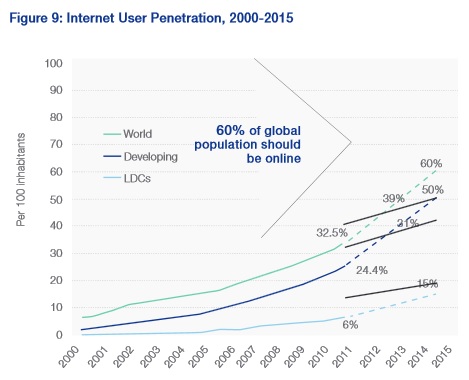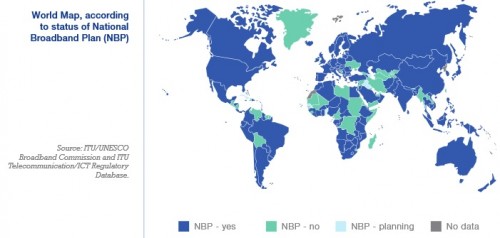African highlights from ‘State of Broadband 2013’ report
The Broadband Commission for Digital Development has released its second snapshot of the state of broadband deployment worldwide.
The State of Broadband 2013: Universalizing Broadband builds upon last year’s theme of “achieving digital inclusion for all.” Again, the Broadband Commission evaluates the roll-out of broadband around the world and tracks progress towards achieving advocacy targets set for boosting broadband access and affordability. It also provides country rankings for 194 economies on internet penetration rates and the status of a national broadband policy.
Global, and even regional trends in broadband technology and adoption are exciting but don’t accurately describe individual countries. In Africa, access varies greatly from one country to another, so even buckets like “developing country” don’t represent the typical SSA nation. Nor do household internet or fixed broadband penetration number apply since African points of access are generally mobile. Still, general trends like the rapid uptake of mobile and slow adoption of internet by “least developed countries” are very pertinent. Also useful are policy recommendations (covered later in this post).

The rate of Internet user penetration is growing more slowly in Sub-Saharan Africa (the majority of LDCs) than in the rest of the world. {ITU}
African mentions in the 104-page report include a variety of examples how ICTs are improving access to crucial services:
- The wireless broadband industry may generate US$7.2bn and 28,000 jobs by 2015 in South Africa.
- In Nigeria, the USF has teamed up with Intel to deploy computers in over 1,000 schools since 2008, helping improve exam results.
- Connect To Learn (CTL) has equipped 10,000 students (especially girls) in schools in Brazil, Chile, China, Djibouti, Ghana, India, Malawi, Kenya, Senegal, South Sudan, Tanzania and Uganda.
- The One Million Community Health Workers Campaign (1mCHW) is making strides in accelerating CHW programs in sub-Saharan Africa to meet the health-related MDGs.
- The Mobile Midwives project allows healthcare workers to monitor records of expectant mothers in Ghana via mobiles.
-
In February 2013, a partnership was announced between Microsoft, the Kenyan ministry of information and communications, Indigo Telecom (a Kenyan ISP), and Adaptrum, a pioneer in white space technologies. The Mawingu project (or “cloud” in Swahili) will deliver low-cost, high-speed wireless broadband to locations unserved by even electricity, connecting poor, remote or low population areas.
- Inveneo has successfully connected distant communities to the internet, such as the remote island of Mfangano located at the mouth of the Winam gulf on the Kenyan side of Lake Victoria.
- In Egypt, only 25%, 25% and 11% of computers in primary, lower secondary and upper secondary schools respectively are connected, constraining Egypt in its efforts to spread a culture of ICT-assisted instruction by a basic lack of devices and internet connectivity.
- Intelsat and Mindset (a developer/ distributor of educational materials in Africa) have partnered to offer distance learning, conferencing and telemedicine via satellite through high-speed internet access and educational materials to schools, hospitals and clinics in South Africa, as well as homes across Africa. Intelsat’s satellite technology is also supporting the fight against HIV/AIDS in Burundi and Burkina Faso.
- SES supports a joint SAHEL-ESA telemedicine project for e-health initiatives and has established a pan-African satellite-enhanced e-health platform to bring training and tailored content to nurses, establish communications between remote healthcare facilities and medical centers of excellence, and collect health data from pilot sites.
- SES facilitated satellite broadband connectivity during recent elections in Burkina Faso, connecting up the Independent Electoral Commission in Burkina Faso (CENI) to support local and legislative elections in December 2012.
- SES is supporting the NGO, Development Alternatives Inc., and USAID in Malawi on the ‘ feed the future’ project, equipping three villages with satellite broadband to educate agricultural communities.
Also:
- An estimated 7% of households have internet access in Africa (next lowest region is 33% for Arab States).
- 59% of African nations have a National Broadband Plan (although many are outdated). Roughly 1/3 of these had a universal access definition.
- There are still several countries which rely exclusively on satellite communication services to deploy broadband connectivity, such as Chad, Eritrea, Guinea, Liberia, and Sierra Leone.

Most African nations have a National Broadband Plan in place – but many such plans are no longer current. {ITU}
Fixed and mobile broadband penetration numbers plus internet usage data (from 2012)
As with all ITU data, these estimates should be taken with a grain of salt:
- Fixed broadband penetration: 12% Seychelles (#62) to 0% for 20 nations (including Tanzania and Nigeria, so we have to question the data)
- Mobile broadband penetration: 33% Ghana (#49) to 0% for 14 nations (plus 9 with no data)
- Households with internet: 42% Mauritius to 1.1% Eritrea (average for a developing country is 24%)
- Individuals using the internet: 55% Morocco (#64) to 0.8% Eritrea (#191)
- 33 of 48 Least Developed Countries are located in Africa. 9 African LDCs have greater than 9% of individuals using the internet (as of 2012)
Global policy recommendations to maximize the impact of broadband apply to Sub-Saharan Africa as well:
- promote market liberalization
- review and update regulatory service obligations
- consider open access approaches to infrastructure
- introduce and develop a National Broadband Plan
- Update and utilize Universal Service Funds
- review licensing schemes
- review and reduce taxation
- review policy frameworks for spectrum
- spur demand and introduce measures to stimulate the creation of local content
- support accurate and timely statistical monitoring
- consider undertaking public consultations on policy
The UN Broadband Commission also has released its first global report on broadband and gender that finds 200 million fewer women online. Stay tuned for more insights!












 Twitter
Twitter Facebook
Facebook Pinterest
Pinterest